Shuhang Gu
School of Electrical and Information Engineering, The University of Sydney, Australia
Learned Image Compression with Dictionary-based Entropy Model
Apr 01, 2025Abstract:Learned image compression methods have attracted great research interest and exhibited superior rate-distortion performance to the best classical image compression standards of the present. The entropy model plays a key role in learned image compression, which estimates the probability distribution of the latent representation for further entropy coding. Most existing methods employed hyper-prior and auto-regressive architectures to form their entropy models. However, they only aimed to explore the internal dependencies of latent representation while neglecting the importance of extracting prior from training data. In this work, we propose a novel entropy model named Dictionary-based Cross Attention Entropy model, which introduces a learnable dictionary to summarize the typical structures occurring in the training dataset to enhance the entropy model. Extensive experimental results have demonstrated that the proposed model strikes a better balance between performance and latency, achieving state-of-the-art results on various benchmark datasets.
Consistency Trajectory Matching for One-Step Generative Super-Resolution
Mar 27, 2025Abstract:Current diffusion-based super-resolution (SR) approaches achieve commendable performance at the cost of high inference overhead. Therefore, distillation techniques are utilized to accelerate the multi-step teacher model into one-step student model. Nevertheless, these methods significantly raise training costs and constrain the performance of the student model by the teacher model. To overcome these tough challenges, we propose Consistency Trajectory Matching for Super-Resolution (CTMSR), a distillation-free strategy that is able to generate photo-realistic SR results in one step. Concretely, we first formulate a Probability Flow Ordinary Differential Equation (PF-ODE) trajectory to establish a deterministic mapping from low-resolution (LR) images with noise to high-resolution (HR) images. Then we apply the Consistency Training (CT) strategy to directly learn the mapping in one step, eliminating the necessity of pre-trained diffusion model. To further enhance the performance and better leverage the ground-truth during the training process, we aim to align the distribution of SR results more closely with that of the natural images. To this end, we propose to minimize the discrepancy between their respective PF-ODE trajectories from the LR image distribution by our meticulously designed Distribution Trajectory Matching (DTM) loss, resulting in improved realism of our recovered HR images. Comprehensive experimental results demonstrate that the proposed methods can attain comparable or even superior capabilities on both synthetic and real datasets while maintaining minimal inference latency.
Progressive Focused Transformer for Single Image Super-Resolution
Mar 26, 2025Abstract:Transformer-based methods have achieved remarkable results in image super-resolution tasks because they can capture non-local dependencies in low-quality input images. However, this feature-intensive modeling approach is computationally expensive because it calculates the similarities between numerous features that are irrelevant to the query features when obtaining attention weights. These unnecessary similarity calculations not only degrade the reconstruction performance but also introduce significant computational overhead. How to accurately identify the features that are important to the current query features and avoid similarity calculations between irrelevant features remains an urgent problem. To address this issue, we propose a novel and effective Progressive Focused Transformer (PFT) that links all isolated attention maps in the network through Progressive Focused Attention (PFA) to focus attention on the most important tokens. PFA not only enables the network to capture more critical similar features, but also significantly reduces the computational cost of the overall network by filtering out irrelevant features before calculating similarities. Extensive experiments demonstrate the effectiveness of the proposed method, achieving state-of-the-art performance on various single image super-resolution benchmarks.
Inductive Gradient Adjustment For Spectral Bias In Implicit Neural Representations
Oct 17, 2024



Abstract:Implicit Neural Representations (INRs), as a versatile representation paradigm, have achieved success in various computer vision tasks. Due to the spectral bias of the vanilla multi-layer perceptrons (MLPs), existing methods focus on designing MLPs with sophisticated architectures or repurposing training techniques for highly accurate INRs. In this paper, we delve into the linear dynamics model of MLPs and theoretically identify the empirical Neural Tangent Kernel (eNTK) matrix as a reliable link between spectral bias and training dynamics. Based on eNTK matrix, we propose a practical inductive gradient adjustment method, which could purposefully improve the spectral bias via inductive generalization of eNTK-based gradient transformation matrix. We evaluate our method on different INRs tasks with various INR architectures and compare to existing training techniques. The superior representation performance clearly validates the advantage of our proposed method. Armed with our gradient adjustment method, better INRs with more enhanced texture details and sharpened edges can be learned from data by tailored improvements on spectral bias.
Causal Context Adjustment Loss for Learned Image Compression
Oct 07, 2024



Abstract:In recent years, learned image compression (LIC) technologies have surpassed conventional methods notably in terms of rate-distortion (RD) performance. Most present learned techniques are VAE-based with an autoregressive entropy model, which obviously promotes the RD performance by utilizing the decoded causal context. However, extant methods are highly dependent on the fixed hand-crafted causal context. The question of how to guide the auto-encoder to generate a more effective causal context benefit for the autoregressive entropy models is worth exploring. In this paper, we make the first attempt in investigating the way to explicitly adjust the causal context with our proposed Causal Context Adjustment loss (CCA-loss). By imposing the CCA-loss, we enable the neural network to spontaneously adjust important information into the early stage of the autoregressive entropy model. Furthermore, as transformer technology develops remarkably, variants of which have been adopted by many state-of-the-art (SOTA) LIC techniques. The existing computing devices have not adapted the calculation of the attention mechanism well, which leads to a burden on computation quantity and inference latency. To overcome it, we establish a convolutional neural network (CNN) image compression model and adopt the unevenly channel-wise grouped strategy for high efficiency. Ultimately, the proposed CNN-based LIC network trained with our Causal Context Adjustment loss attains a great trade-off between inference latency and rate-distortion performance.
NTIRE 2024 Challenge on Stereo Image Super-Resolution: Methods and Results
Sep 25, 2024Abstract:This paper summarizes the 3rd NTIRE challenge on stereo image super-resolution (SR) with a focus on new solutions and results. The task of this challenge is to super-resolve a low-resolution stereo image pair to a high-resolution one with a magnification factor of x4 under a limited computational budget. Compared with single image SR, the major challenge of this challenge lies in how to exploit additional information in another viewpoint and how to maintain stereo consistency in the results. This challenge has 2 tracks, including one track on bicubic degradation and one track on real degradations. In total, 108 and 70 participants were successfully registered for each track, respectively. In the test phase, 14 and 13 teams successfully submitted valid results with PSNR (RGB) scores better than the baseline. This challenge establishes a new benchmark for stereo image SR.
PerlDiff: Controllable Street View Synthesis Using Perspective-Layout Diffusion Models
Jul 08, 2024



Abstract:Controllable generation is considered a potentially vital approach to address the challenge of annotating 3D data, and the precision of such controllable generation becomes particularly imperative in the context of data production for autonomous driving. Existing methods focus on the integration of diverse generative information into controlling inputs, utilizing frameworks such as GLIGEN or ControlNet, to produce commendable outcomes in controllable generation. However, such approaches intrinsically restrict generation performance to the learning capacities of predefined network architectures. In this paper, we explore the integration of controlling information and introduce PerlDiff (Perspective-Layout Diffusion Models), a method for effective street view image generation that fully leverages perspective 3D geometric information. Our PerlDiff employs 3D geometric priors to guide the generation of street view images with precise object-level control within the network learning process, resulting in a more robust and controllable output. Moreover, it demonstrates superior controllability compared to alternative layout control methods. Empirical results justify that our PerlDiff markedly enhances the precision of generation on the NuScenes and KITTI datasets. Our codes and models are publicly available at https://github.com/LabShuHangGU/PerlDiff.
Stereo Risk: A Continuous Modeling Approach to Stereo Matching
Jul 03, 2024Abstract:We introduce Stereo Risk, a new deep-learning approach to solve the classical stereo-matching problem in computer vision. As it is well-known that stereo matching boils down to a per-pixel disparity estimation problem, the popular state-of-the-art stereo-matching approaches widely rely on regressing the scene disparity values, yet via discretization of scene disparity values. Such discretization often fails to capture the nuanced, continuous nature of scene depth. Stereo Risk departs from the conventional discretization approach by formulating the scene disparity as an optimal solution to a continuous risk minimization problem, hence the name "stereo risk". We demonstrate that $L^1$ minimization of the proposed continuous risk function enhances stereo-matching performance for deep networks, particularly for disparities with multi-modal probability distributions. Furthermore, to enable the end-to-end network training of the non-differentiable $L^1$ risk optimization, we exploited the implicit function theorem, ensuring a fully differentiable network. A comprehensive analysis demonstrates our method's theoretical soundness and superior performance over the state-of-the-art methods across various benchmark datasets, including KITTI 2012, KITTI 2015, ETH3D, SceneFlow, and Middlebury 2014.
PPRSteg: Printing and Photography Robust QR Code Steganography via Attention Flow-Based Model
May 26, 2024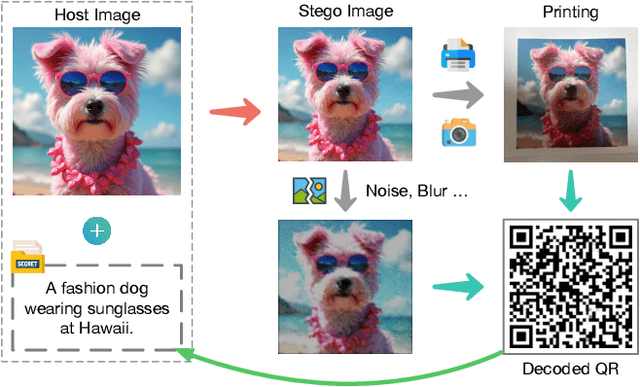
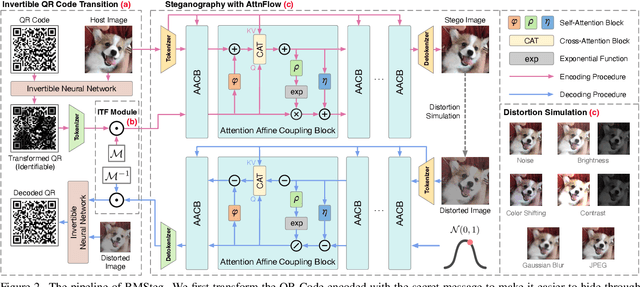

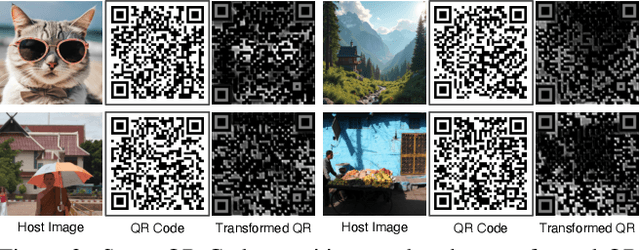
Abstract:Image steganography can hide information in a host image and obtain a stego image that is perceptually indistinguishable from the original one. This technique has tremendous potential in scenarios like copyright protection, information retrospection, etc. Some previous studies have proposed to enhance the robustness of the methods against image disturbances to increase their applicability. However, they generally cannot achieve a satisfying balance between the steganography quality and robustness. In this paper, we focus on the issue of QR Code steganography that is robust to real-world printing and photography. Different from common image steganography, QR Code steganography aims to embed a non-natural image into a natural image and the restored QR Code is required to be recognizable, which increases the difficulty of data concealing and revealing. Inspired by the recent developments in transformer-based vision models, we discover that the tokenized representation of images is naturally suitable for steganography. In this paper, we propose a novel QR Code embedding framework, called Printing and Photography Robust Steganography (PPRSteg), which is competent to hide QR Code in a host image with unperceivable changes and can restore it even if the stego image is printed out and photoed. We outline a transition process to reduce the artifacts in stego images brought by QR Codes. We also propose a steganography model based on normalizing flow, which combines the attention mechanism to enhance its performance. To our best knowledge, this is the first work that integrates the advantages of transformer models into normalizing flow. We conduct comprehensive and detailed experiments to demonstrate the effectiveness of our method and the result shows that PPRSteg has great potential in robust, secure and high-quality QR Code steganography.
NTIRE 2024 Challenge on Low Light Image Enhancement: Methods and Results
Apr 22, 2024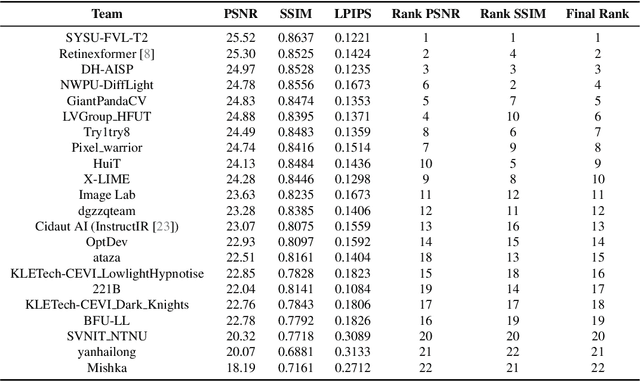

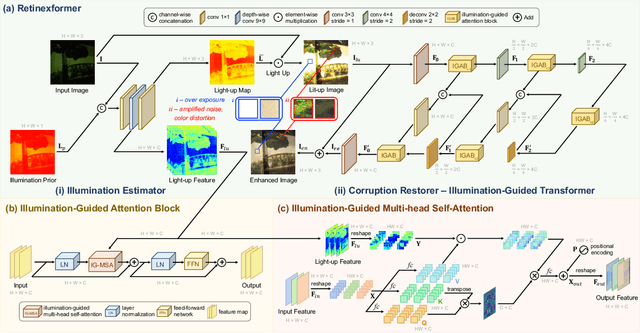

Abstract:This paper reviews the NTIRE 2024 low light image enhancement challenge, highlighting the proposed solutions and results. The aim of this challenge is to discover an effective network design or solution capable of generating brighter, clearer, and visually appealing results when dealing with a variety of conditions, including ultra-high resolution (4K and beyond), non-uniform illumination, backlighting, extreme darkness, and night scenes. A notable total of 428 participants registered for the challenge, with 22 teams ultimately making valid submissions. This paper meticulously evaluates the state-of-the-art advancements in enhancing low-light images, reflecting the significant progress and creativity in this field.
 Add to Chrome
Add to Chrome Add to Firefox
Add to Firefox Add to Edge
Add to Edge